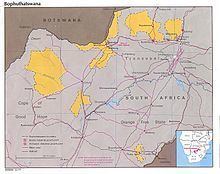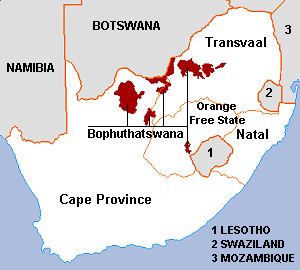Flag Coat of arms Legislature Parliament Founded 1977 | Self-government 1 June 1972 Area 44,109 km² Date dissolved 1994 | |
 | ||
Languages TswanaEnglishAfrikaans National Assembly 24 regional representatives12 non-voting specialists72 elected MPs Government Bantustan, Republic, Parliamentary system | ||
Bophuthatswana (/ˌboʊpuːtətˈswɑːnə/, meaning "gathering of the Tswana people"), officially the Republic of Bophuthatswana (Tswana: Repaboleki ya Bophuthatswana; Afrikaans: Republiek van Bophuthatswana), was a Bantustan ("homeland"; an area set aside for members of a specific ethnicity) and nominal parliamentary democracy in the northwestern region of South Africa. Its seat of government was Mmabatho.
Contents
- Establishment
- International reaction
- Series of coups dtat
- Coup of 1994
- Dissolution
- Geography and demographics
- Economy
- Security forces
- Districts in 1991
- Coins
- References

Bophuthatswana was the first area to be declared an independent state whose territory constituted a scattered patchwork of individual enclaves. During its last days of existence, events taking place within its borders led to the weakening and split of right-wing Afrikaner resistance towards democratizing South Africa.

In 1994, it was reintegrated into South Africa, and its territory was distributed among the new provinces of the Orange Free State (now Free State), Northern Cape, and North West Province.

Establishment

The area was set up as the only homeland for Tswana-speaking people in 1961. It was given nominal self-rule in 1971, and elections were held the following year. Following the 1977 elections, Lucas Mangope became president after his Bophuthatswana Democratic Party won a majority of seats. The territory became nominally independent on 6 December 1977. In the 1982 elections, the Democratic Party won all 72 elected seats. It also won a large majority in the 1987 elections.
International reaction

Bophuthatswana's independence was not recognized by any government other than those of South Africa and Transkei, the first homeland to gain nominal independence. In addition, it was later internally recognized by the two additional countries within the TBVC-system, Ciskei and Venda.

Despite its official isolation, however, the government in Mmabatho managed to set up a trade mission in Tel Aviv, Israel, and conducted some business with neighbouring Botswana in an effort to sway attitudes; furthermore, Botswana agreed on "informal arrangements" short of official recognition in order to facilitate cross-border travel.
Arguing in favour of independence, President Mangope claimed that the move would enable its population to negotiate with South Africa from a stronger position: "We would rather face the difficulties of administering a fragmented territory, the wrath of the outside world, and accusations of ill-informed people. It's the price we are prepared to pay for being masters of our own destiny."
United Nations Secretary-General Kurt Waldheim stated that he "strongly deplored" the establishment of "another so-called independent tribal homeland in pursuance of the discredited policies of apartheid," and in resolution A/RES/32/105N, passed on 14 December 1977, the United Nations General Assembly linked Bophuthatswana's "so-called 'independence'" to South Africa's "stubborn pursuit" of its policies, and called upon all governments to "deny any form of recognition to the so-called 'independent' bantustans." During a parliamentary debate in Britain on 6 December 1977, Foreign Secretary David Owen replied in the negative when asked "whether Her Majesty's Government intend to recognise travel documents issued by the authorities of [...] Bophuthatswana for the purpose of admitting visitors to the United Kingdom."
While the majority of news reports echoed these official declarations, there were others which opined that Western critics should "suspend judgment for a time," and despite its generally critical stance on South Africa's policies, Time magazine wrote that Bophuthatswana had "considerable economic potential" with an expected $30 million a year coming from mining revenues.
Bophuthatswana maintained an unofficial embassy in Israel during the 1980s, located next to the British embassy in Tel Aviv. The Israeli Foreign Ministry objected to the embassy's presence, as Israel did not recognize Bophuthatswana as a country. The bantustan's president, Lucas Mangope, was nevertheless able to meet with prominent figures such as Moshe Dayan during visits to Israel.
Series of coups d'état
On 10 February 1988 Rocky Malebane-Metsing of the People's Progressive Party (PPP) became the President of Bophuthatswana for one day when he took over the government through a military coup. He accused Mangope of corruption and charged that the recent election had been rigged in the government's favour. A statement by the defence force said "serious and disturbing matters of great concern" had emerged, citing Mangope's close association with a multimillionaire Soviet emigre. During the subsequent invasion by the South African Defence Force, Mangope was reinstated and continued his term unabated. P. W. Botha, president of South Africa at the time, justified the reinstatement by saying that "[t]he South African Government is opposed in principle to the obtaining or maintaining of power by violence."
In 1990, during a second coup in which an estimated 50,000 protesters demanded the president's resignation over his handling of the economy, the New York Times reported that seven people had been killed and 450 wounded "after police officers in armoured cars fired their rifles into the crowds and used tear gas and rubber bullets." After Mangope had asked for help from the South African government, he declared a state of emergency and cut telephone links to the territory "for political reasons," claiming that "normal laws had become inadequate." Human Rights Watch put the number of protesters at 150,000.
Coup of 1994
In the beginning of 1994 with South Africa heading for democratic elections, the President Lucas Mangope resisted reincorporation into South Africa. Forty people were wounded when Bophuthatswana Defence Force troops opened fire on striking civil servants. Mangope took an increasingly hardline stance, rejected Independent Electoral Commission chairman Judge Johann Kriegler's plea for free political activity in the territory, and fired the staff of the Bophuthatswana Broadcasting Corporation, closing down two television stations and three radio stations.
The white supremacist group Afrikaner Weerstandsbeweging (AWB) took the opportunity to move in and try to restore the apartheid status quo, but was humiliated in early March when, in the presence of photojournalists and a TV crew, uniformed members of the AWB on an armed incursion to the Mmabatho/Mafikeng area shot at unarmed civilians blocking the road, injuring and killing many. They themselves were shot at by members of the Bophuthatswana Defence Force (BDF) and the Police and forced to retreat. One member of the AWB travelling back in a blue Mercedes Benz shot at some people along the road and members of Bophuthatswana police opened fire at the car. The driver, Nicolaas Fourie, and his two passengers promptly surrendered and were disarmed. After allowing the media to photograph the badly injured prisoners, they were then executed at point blank range by an ANC-supporting Bophuthatswana policeman, Ontlametse Bernstein Menyatsoe. These killings effectively spelt the end of white right-wing military opposition to democratic reforms. Mangope was replaced by an interim government.
Dissolution
With the end of apartheid, of the 7 enclaves, 6 were added into the North West Province. Thaba Nchu became part of the Free State. The capital, Mmabatho, was merged with Mafikeng and the combined city is now the capital of the North West province.
Geography and demographics
Bophuthatswana had a surface area of approximately 40 000 km² and consisted of seven enclaves dispersed over the former South African provinces of Cape Province, Transvaal, and Orange Free State. The capital, Mmabatho, was situated in an area bordering Botswana. Following a local referendum on the issue, nearby Mafeking joined Bophuthatswana in 1980, three years after Bophuthatswana was awarded independence.
The homeland was set up to house Setswana-speaking peoples. In 1983, it had more than 1,430,000 inhabitants; in 1990, it had an estimated population of 2,352,296. Only 10% of Bophuthatswana's total land area was arable, and much of that was covered with scrub brush.
Though the majority of its population was Tswana-speaking, Tswana, English, and Afrikaans were all designated as official languages by the constitution.
Economy
Bophuthatswana was the richest of the TBVC-states as it had platinum mines, which accounted for two-thirds of the total platinum production in the Western world. It was also rich in asbestos, granite, vanadium, chromium and manganese. Additional revenues came from the Sun City casino, which was a day trip from Johannesburg and Pretoria, where gambling was illegal under the National Party government, as it was throughout all of South Africa.
Bophuthatswana also issued bearer development bonds. The so-called "Bop Bonds" are not recognized or redeemable in South Africa, and are worthless as financial instruments. However, bonds in excellent condition are considered collectible. Bonds issued in 1988 and 1989, in R10 and R20 denominations, currently trade at 10-25% of original face value.
Security forces
Towards the end of its existence, the Bophuthatswana Defence Force (BDF) had an estimated number of 4,000 troops, mostly infantry. It was organized into six military regions, and its ground forces included two infantry battalions, possessing two armoured personnel carriers. The Bophuthatswana Air Force of 150 personnel possessed three combat aircraft and two armed helicopters. The president was commander-in-chief and was authorised to deploy the armed forces in both cross-border operations as well as domestically.
During its last days in 1994, the Bophuthatswana Police had 6,002 police officers, operating from 56 police stations throughout the territory.
With the dissolution of Bophuthatswana in 1994, the BDF and the Bophuthatswana Police were incorporated into the South African National Defence Force and the South African Police Service, respectively.
Districts in 1991
Districts of the province and population at the 1991 census.
Coins
Bophuthatswana was the first and only Bantustan to produce its own coins. Two coins were minted as a proof set only, the South African Rand remained the official currency.
